Attached files
| file | filename |
|---|---|
| EX-99.1 - PRESS RELEASE - Walmart Inc. | earningsrelease-7312018.htm |
| 8-K - FORM 8-K - Walmart Inc. | form8-kx7312018.htm |
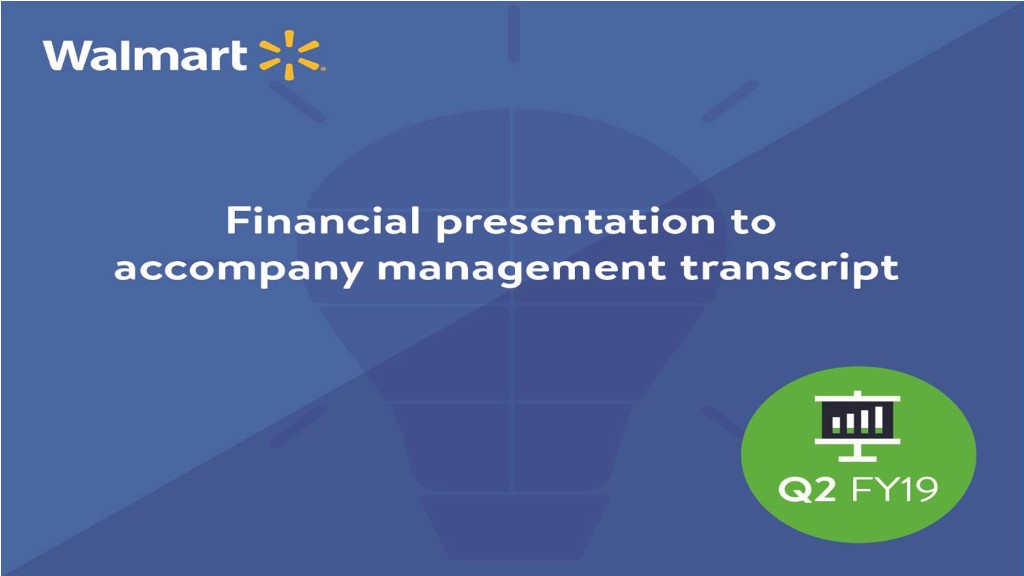
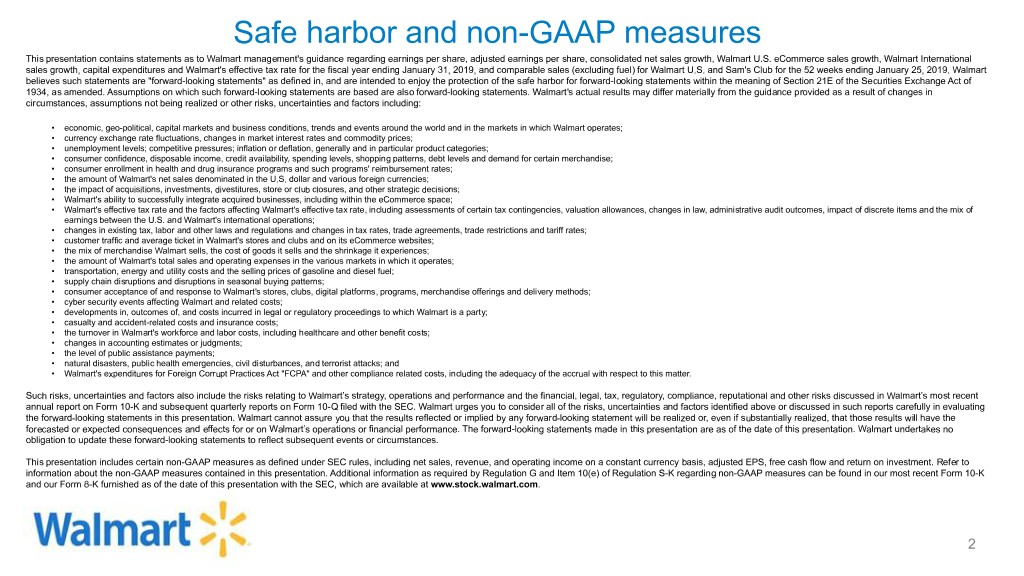
Safe harbor and non-GAAP measures This presentation contains statements as to Walmart management's guidance regarding earnings per share, adjusted earnings per share, consolidated net sales growth, Walmart U.S. eCommerce sales growth, Walmart International sales growth, capital expenditures and Walmart's effective tax rate for the fiscal year ending January 31, 2019, and comparable sales (excluding fuel) for Walmart U.S. and Sam's Club for the 52 weeks ending January 25, 2019. Walmart believes such statements are "forward-looking statements" as defined in, and are intended to enjoy the protection of the safe harbor for forward-looking statements within the meaning of Section 21E of the Securities Exchange Act of 1934, as amended. Assumptions on which such forward-looking statements are based are also forward-looking statements. Walmart's actual results may differ materially from the guidance provided as a result of changes in circumstances, assumptions not being realized or other risks, uncertainties and factors including: • economic, geo-political, capital markets and business conditions, trends and events around the world and in the markets in which Walmart operates; • currency exchange rate fluctuations, changes in market interest rates and commodity prices; • unemployment levels; competitive pressures; inflation or deflation, generally and in particular product categories; • consumer confidence, disposable income, credit availability, spending levels, shopping patterns, debt levels and demand for certain merchandise; • consumer enrollment in health and drug insurance programs and such programs' reimbursement rates; • the amount of Walmart's net sales denominated in the U.S. dollar and various foreign currencies; • the impact of acquisitions, investments, divestitures, store or club closures, and other strategic decisions; • Walmart's ability to successfully integrate acquired businesses, including within the eCommerce space; • Walmart's effective tax rate and the factors affecting Walmart's effective tax rate, including assessments of certain tax contingencies, valuation allowances, changes in law, administrative audit outcomes, impact of discrete items and the mix of earnings between the U.S. and Walmart's international operations; • changes in existing tax, labor and other laws and regulations and changes in tax rates, trade agreements, trade restrictions and tariff rates; • customer traffic and average ticket in Walmart's stores and clubs and on its eCommerce websites; • the mix of merchandise Walmart sells, the cost of goods it sells and the shrinkage it experiences; • the amount of Walmart's total sales and operating expenses in the various markets in which it operates; • transportation, energy and utility costs and the selling prices of gasoline and diesel fuel; • supply chain disruptions and disruptions in seasonal buying patterns; • consumer acceptance of and response to Walmart's stores, clubs, digital platforms, programs, merchandise offerings and delivery methods; • cyber security events affecting Walmart and related costs; • developments in, outcomes of, and costs incurred in legal or regulatory proceedings to which Walmart is a party; • casualty and accident-related costs and insurance costs; • the turnover in Walmart's workforce and labor costs, including healthcare and other benefit costs; • changes in accounting estimates or judgments; • the level of public assistance payments; • natural disasters, public health emergencies, civil disturbances, and terrorist attacks; and • Walmart's expenditures for Foreign Corrupt Practices Act "FCPA" and other compliance related costs, including the adequacy of the accrual with respect to this matter. Such risks, uncertainties and factors also include the risks relating to Walmart’s strategy, operations and performance and the financial, legal, tax, regulatory, compliance, reputational and other risks discussed in Walmart’s most recent annual report on Form 10-K and subsequent quarterly reports on Form 10-Q filed with the SEC. Walmart urges you to consider all of the risks, uncertainties and factors identified above or discussed in such reports carefully in evaluating the forward-looking statements in this presentation. Walmart cannot assure you that the results reflected or implied by any forward-looking statement will be realized or, even if substantially realized, that those results will have the forecasted or expected consequences and effects for or on Walmart’s operations or financial performance. The forward-looking statements made in this presentation are as of the date of this presentation. Walmart undertakes no obligation to update these forward-looking statements to reflect subsequent events or circumstances. This presentation includes certain non-GAAP measures as defined under SEC rules, including net sales, revenue, and operating income on a constant currency basis, adjusted EPS, free cash flow and return on investment. Refer to information about the non-GAAP measures contained in this presentation. Additional information as required by Regulation G and Item 10(e) of Regulation S-K regarding non-GAAP measures can be found in our most recent Form 10-K and our Form 8-K furnished as of the date of this presentation with the SEC, which are available at www.stock.walmart.com. 2
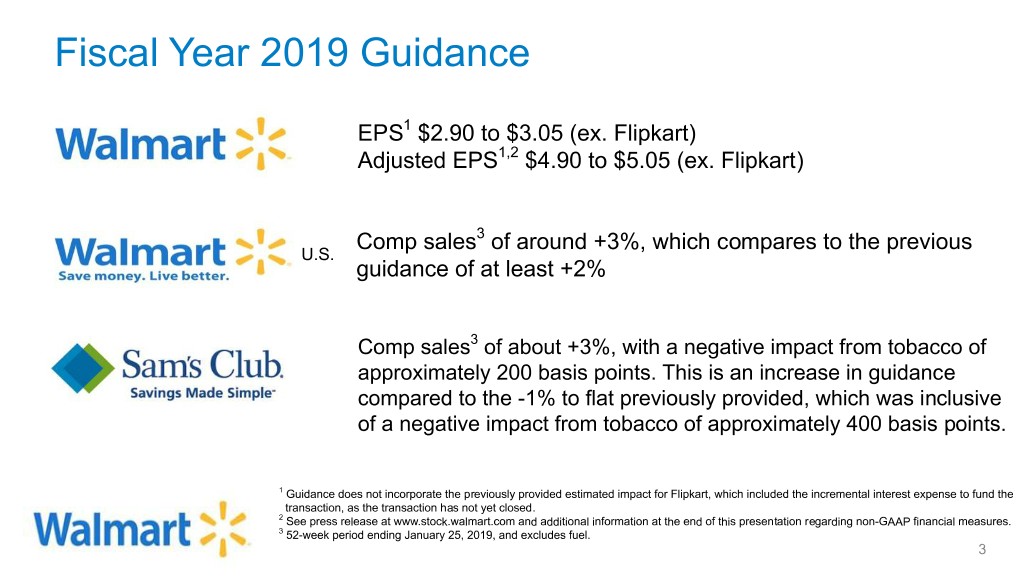
Fiscal Year 2019 Guidance EPS1 $2.90 to $3.05 (ex. Flipkart) Adjusted EPS1,2 $4.90 to $5.05 (ex. Flipkart) Comp sales3 of around +3%, which compares to the previous U.S. guidance of at least +2% Comp sales3 of about +3%, with a negative impact from tobacco of approximately 200 basis points. This is an increase in guidance compared to the -1% to flat previously provided, which was inclusive of a negative impact from tobacco of approximately 400 basis points. 1 Guidance does not incorporate the previously provided estimated impact for Flipkart, which included the incremental interest expense to fund the transaction, as the transaction has not yet closed. 2 See press release at www.stock.walmart.com and additional information at the end of this presentation regarding non-GAAP financial measures. 3 52-week period ending January 25, 2019, and excludes fuel. 3
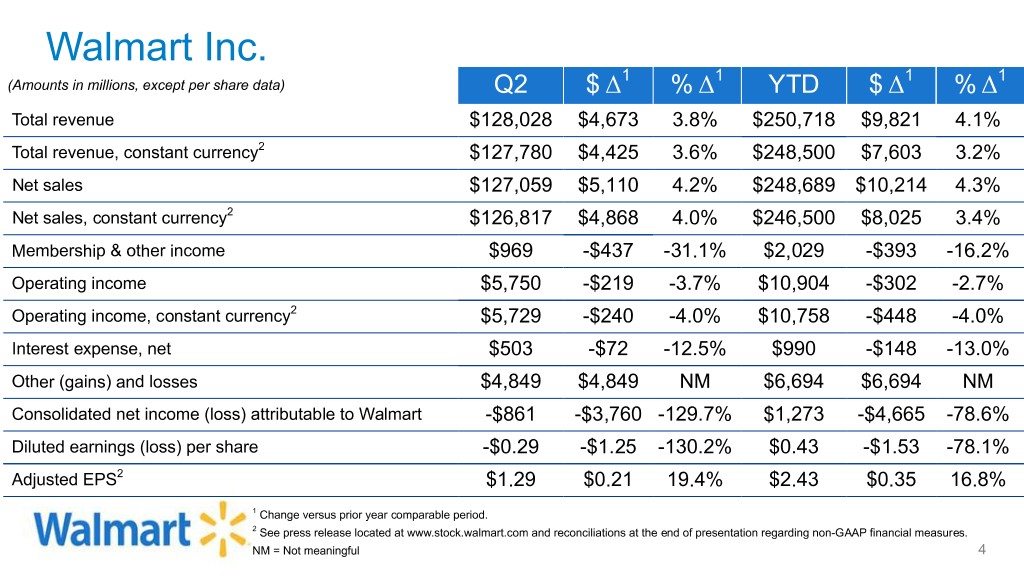
Walmart Inc. 1 1 1 1 (Amounts in millions, except per share data) Q2 $ Δ % Δ YTD $ Δ % Δ Total revenue $128,028 $4,673 3.8% $250,718 $9,821 4.1% Total revenue, constant currency2 $127,780 $4,425 3.6% $248,500 $7,603 3.2% Net sales $127,059 $5,110 4.2% $248,689 $10,214 4.3% Net sales, constant currency2 $126,817 $4,868 4.0% $246,500 $8,025 3.4% Membership & other income $969 -$437 -31.1% $2,029 -$393 -16.2% Operating income $5,750 -$219 -3.7% $10,904 -$302 -2.7% Operating income, constant currency2 $5,729 -$240 -4.0% $10,758 -$448 -4.0% Interest expense, net $503 -$72 -12.5% $990 -$148 -13.0% Other (gains) and losses $4,849 $4,849 NM $6,694 $6,694 NM Consolidated net income (loss) attributable to Walmart -$861 -$3,760 -129.7% $1,273 -$4,665 -78.6% Diluted earnings (loss) per share -$0.29 -$1.25 -130.2% $0.43 -$1.53 -78.1% Adjusted EPS2 $1.29 $0.21 19.4% $2.43 $0.35 16.8% 1 Change versus prior year comparable period. 2 See press release located at www.stock.walmart.com and reconciliations at the end of presentation regarding non-GAAP financial measures. NM = Not meaningful 4
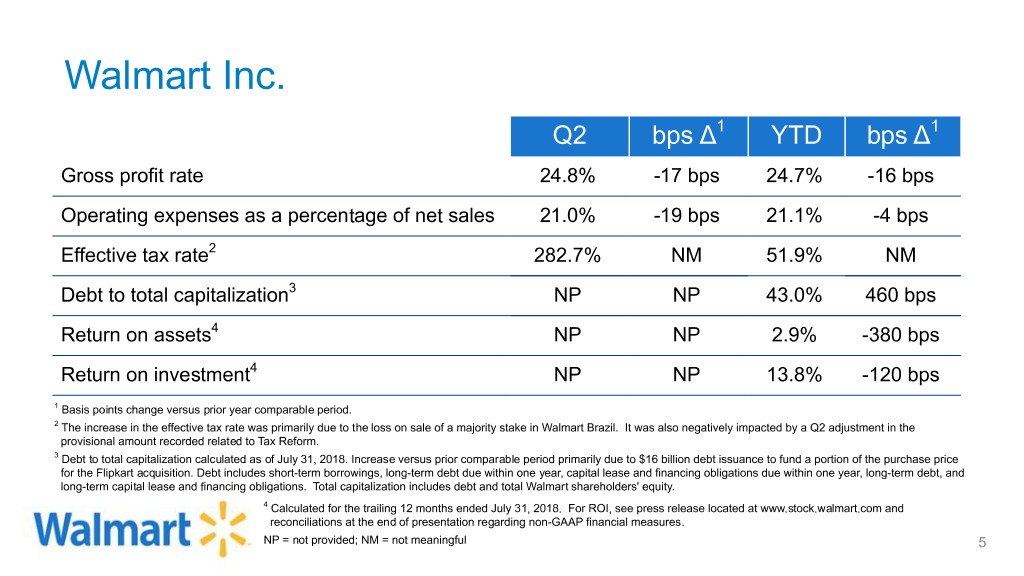
Walmart Inc. Q2 bps Δ1 YTD bps Δ1 Gross profit rate 24.8% -17 bps 24.7% -16 bps Operating expenses as a percentage of net sales 21.0% -19 bps 21.1% -4 bps Effective tax rate2 282.7% NM 51.9% NM Debt to total capitalization3 NP NP 43.0% 460 bps Return on assets4 NP NP 2.9% -380 bps Return on investment4 NP NP 13.8% -120 bps 1 Basis points change versus prior year comparable period. 2 The increase in the effective tax rate was primarily due to the loss on sale of a majority stake in Walmart Brazil. It was also negatively impacted by a Q2 adjustment in the provisional amount recorded related to Tax Reform. 3 Debt to total capitalization calculated as of July 31, 2018. Increase versus prior comparable period primarily due to $16 billion debt issuance to fund a portion of the purchase price for the Flipkart acquisition. Debt includes short-term borrowings, long-term debt due within one year, capital lease and financing obligations due within one year, long-term debt, and long-term capital lease and financing obligations. Total capitalization includes debt and total Walmart shareholders' equity. 4 Calculated for the trailing 12 months ended July 31, 2018. For ROI, see press release located at www.stock.walmart.com and reconciliations at the end of presentation regarding non-GAAP financial measures. NP = not provided; NM = not meaningful 5
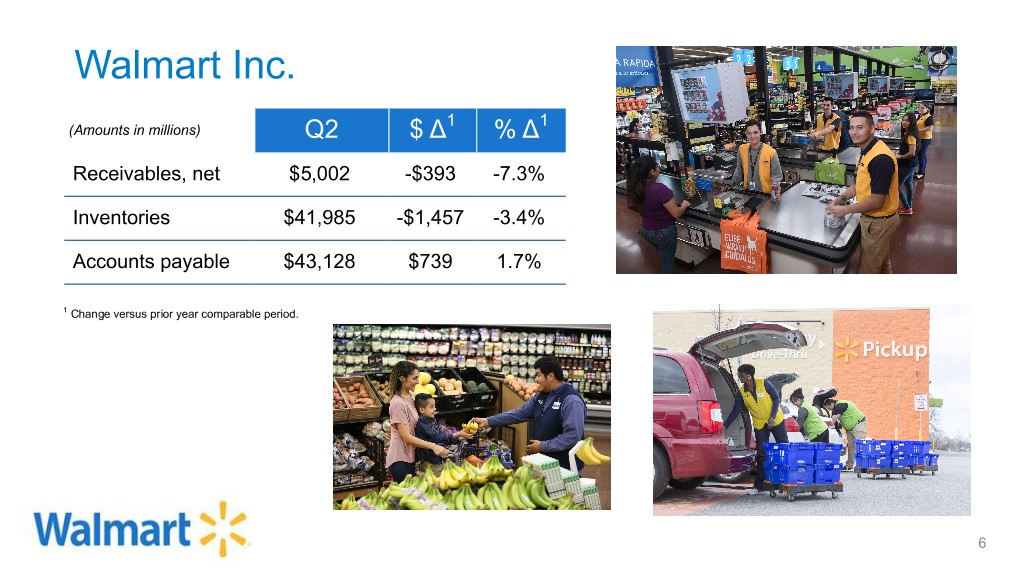
Walmart Inc. 1 1 (Amounts in millions) Q2 $ Δ % Δ Receivables, net $5,002 -$393 -7.3% Inventories $41,985 -$1,457 -3.4% Accounts payable $43,128 $739 1.7% 1 Change versus prior year comparable period. 6

Walmart Inc. 1 (Amounts in millions) YTD $ Δ Operating cash flow 11,095 -265 Capital expenditures 4,282 -141 Free cash flow2 6,813 -124 1 1 (Amounts in millions) Q2 % Δ YTD % Δ Dividends 1,534 -0.3% $3,067 -0.7% Share repurchases3 1,305 -42.3% $1,844 -58.5% Total $2,839 -25.3% $4,911 -34.8% 1 Change versus prior year comparable period. 2 See press release located at www.stock.walmart.com and reconciliations at the end of this presentation regarding non- GAAP financial measures. 3 $16.9 billion remaining of the $20 billion authorization approved in October 2017. The company repurchased 7 approximately 15.3 million shares in Q2.
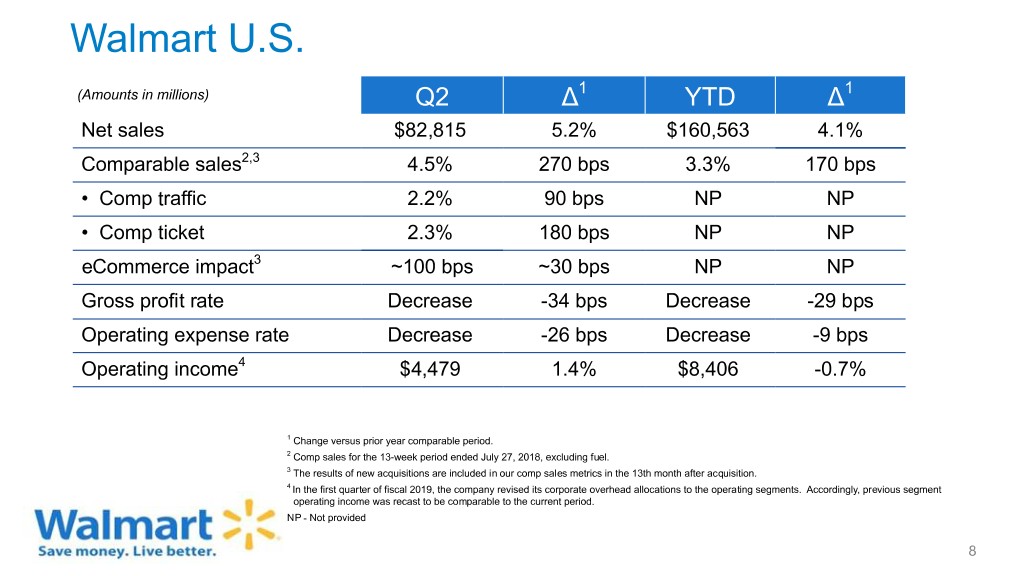
Walmart U.S. (Amounts in millions) Q2 Δ1 YTD Δ1 Net sales $82,815 5.2% $160,563 4.1% Comparable sales2,3 4.5% 270 bps 3.3% 170 bps • Comp traffic 2.2% 90 bps NP NP • Comp ticket 2.3% 180 bps NP NP eCommerce impact3 ~100 bps ~30 bps NP NP Gross profit rate Decrease -34 bps Decrease -29 bps Operating expense rate Decrease -26 bps Decrease -9 bps Operating income4 $4,479 1.4% $8,406 -0.7% 1 Change versus prior year comparable period. 2 Comp sales for the 13-week period ended July 27, 2018, excluding fuel. 3 The results of new acquisitions are included in our comp sales metrics in the 13th month after acquisition. 4 In the first quarter of fiscal 2019, the company revised its corporate overhead allocations to the operating segments. Accordingly, previous segment operating income was recast to be comparable to the current period. NP - Not provided 8
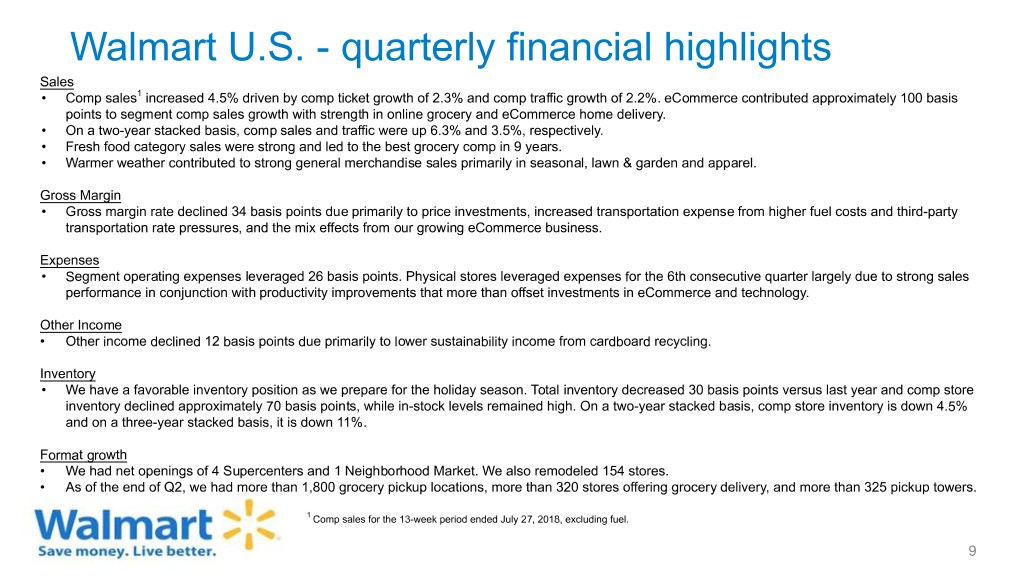
Walmart U.S. - quarterly financial highlights Sales • Comp sales1 increased 4.5% driven by comp ticket growth of 2.3% and comp traffic growth of 2.2%. eCommerce contributed approximately 100 basis points to segment comp sales growth with strength in online grocery and eCommerce home delivery. • On a two-year stacked basis, comp sales and traffic were up 6.3% and 3.5%, respectively. • Fresh food category sales were strong and led to the best grocery comp in 9 years. • Warmer weather contributed to strong general merchandise sales primarily in seasonal, lawn & garden and apparel. Gross Margin • Gross margin rate declined 34 basis points due primarily to price investments, increased transportation expense from higher fuel costs and third-party transportation rate pressures, and the mix effects from our growing eCommerce business. Expenses • Segment operating expenses leveraged 26 basis points. Physical stores leveraged expenses for the 6th consecutive quarter largely due to strong sales performance in conjunction with productivity improvements that more than offset investments in eCommerce and technology. Other Income • Other income declined 12 basis points due primarily to lower sustainability income from cardboard recycling. Inventory • We have a favorable inventory position as we prepare for the holiday season. Total inventory decreased 30 basis points versus last year and comp store inventory declined approximately 70 basis points, while in-stock levels remained high. On a two-year stacked basis, comp store inventory is down 4.5% and on a three-year stacked basis, it is down 11%. Format growth • We had net openings of 4 Supercenters and 1 Neighborhood Market. We also remodeled 154 stores. • As of the end of Q2, we had more than 1,800 grocery pickup locations, more than 320 stores offering grocery delivery, and more than 325 pickup towers. 1 Comp sales for the 13-week period ended July 27, 2018, excluding fuel. 9
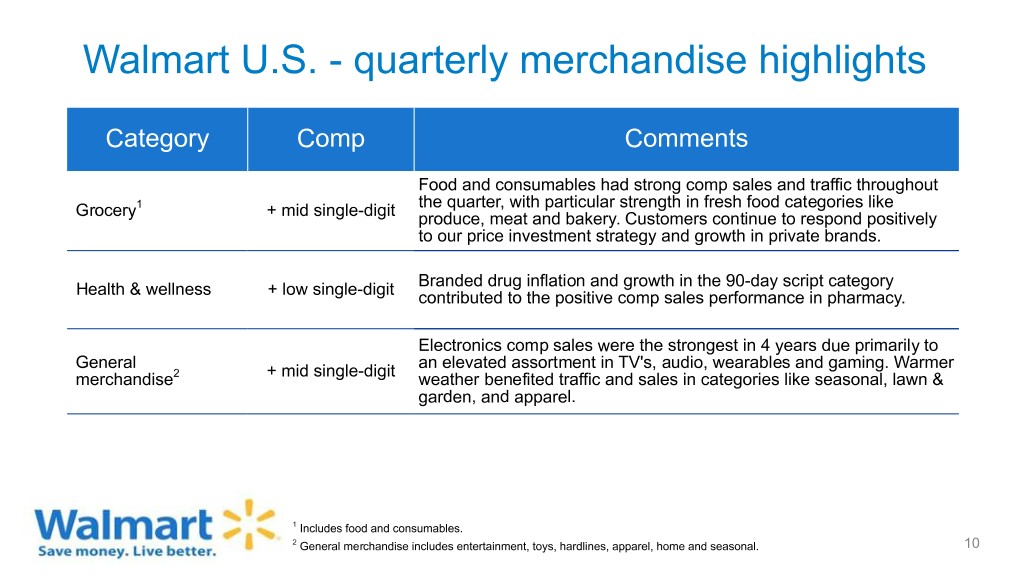
Walmart U.S. - quarterly merchandise highlights Category Comp Comments Food and consumables had strong comp sales and traffic throughout 1 the quarter, with particular strength in fresh food categories like Grocery + mid single-digit produce, meat and bakery. Customers continue to respond positively to our price investment strategy and growth in private brands. Branded drug inflation and growth in the 90-day script category Health & wellness + low single-digit contributed to the positive comp sales performance in pharmacy. Electronics comp sales were the strongest in 4 years due primarily to General an elevated assortment in TV's, audio, wearables and gaming. Warmer merchandise2 + mid single-digit weather benefited traffic and sales in categories like seasonal, lawn & garden, and apparel. 1 Includes food and consumables. 2 General merchandise includes entertainment, toys, hardlines, apparel, home and seasonal. 10
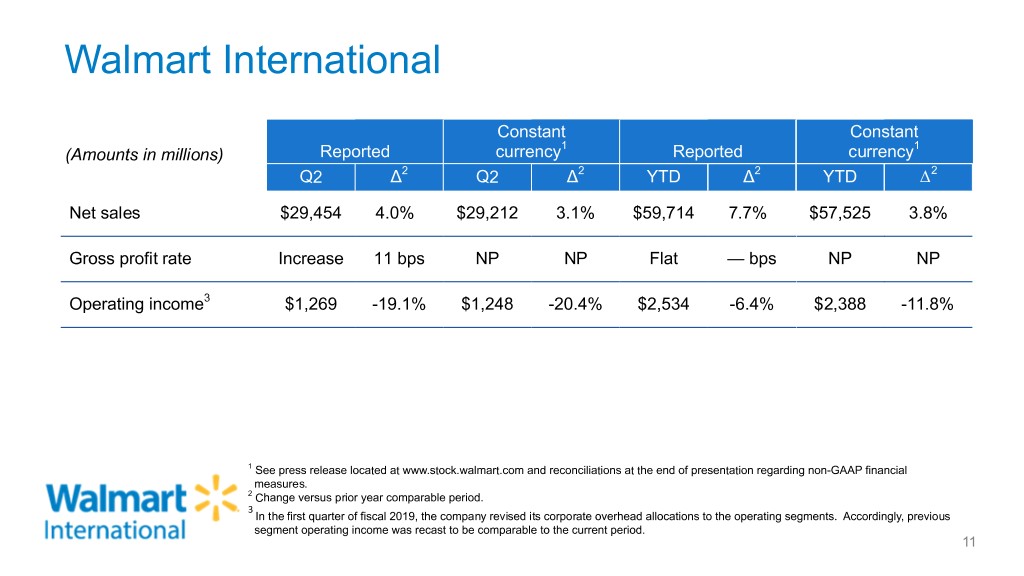
Walmart International Constant Constant 1 1 (Amounts in millions) Reported currency Reported currency Q2 Δ2 Q2 Δ2 YTD1 Δ2 YTD Δ2 Net sales $29,454 4.0% $29,212 3.1% $59,714 7.7% $57,525 3.8% Gross profit rate Increase 11 bps NP NP Flat — bps NP NP Operating income3 $1,269 -19.1% $1,248 -20.4% $2,534 -6.4% $2,388 -11.8% 1 See press release located at www.stock.walmart.com and reconciliations at the end of presentation regarding non-GAAP financial measures. 2 Change versus prior year comparable period. 3 In the first quarter of fiscal 2019, the company revised its corporate overhead allocations to the operating segments. Accordingly, previous segment operating income was recast to be comparable to the current period. 11
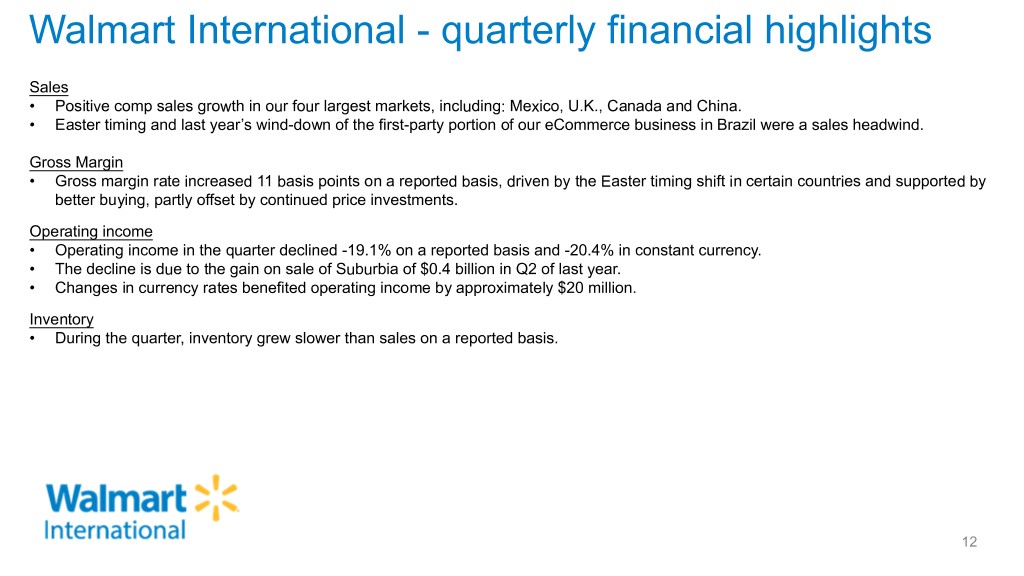
Walmart International - quarterly financial highlights Sales • Positive comp sales growth in our four largest markets, including: Mexico, U.K., Canada and China. • Easter timing and last year’s wind-down of the first-party portion of our eCommerce business in Brazil were a sales headwind. Gross Margin • Gross margin rate increased 11 basis points on a reported basis, driven by the Easter timing shift in certain countries and supported by better buying, partly offset by continued price investments. Operating income • Operating income in the quarter declined -19.1% on a reported basis and -20.4% in constant currency. • The decline is due to the gain on sale of Suburbia of $0.4 billion in Q2 of last year. • Changes in currency rates benefited operating income by approximately $20 million. Inventory • During the quarter, inventory grew slower than sales on a reported basis. 12
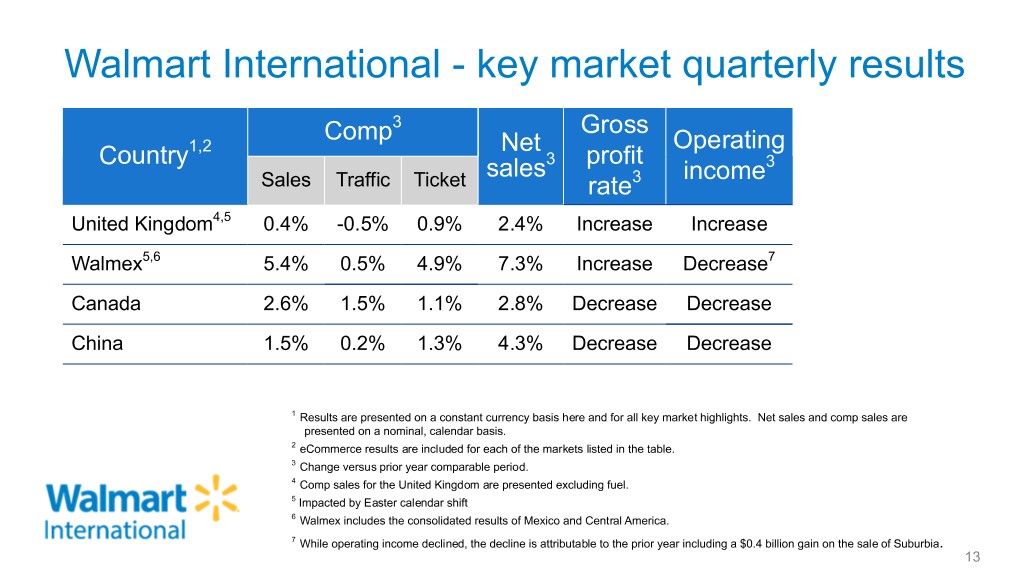
Walmart International - key market quarterly results Comp3 Gross 1,2 Net Operating Country 3 profit sales income3 Sales Traffic Ticket rate3 United Kingdom4,5 0.4% -0.5% 0.9% 2.4% Increase Increase Walmex5,6 5.4% 0.5% 4.9% 7.3% Increase Decrease7 Canada 2.6% 1.5% 1.1% 2.8% Decrease Decrease China 1.5% 0.2% 1.3% 4.3% Decrease Decrease 1 Results are presented on a constant currency basis here and for all key market highlights. Net sales and comp sales are presented on a nominal, calendar basis. 2 eCommerce results are included for each of the markets listed in the table. 3 Change versus prior year comparable period. 4 Comp sales for the United Kingdom are presented excluding fuel. 5 Impacted by Easter calendar shift 6 Walmex includes the consolidated results of Mexico and Central America. 7 While operating income declined, the decline is attributable to the prior year including a $0.4 billion gain on the sale of Suburbia. 13
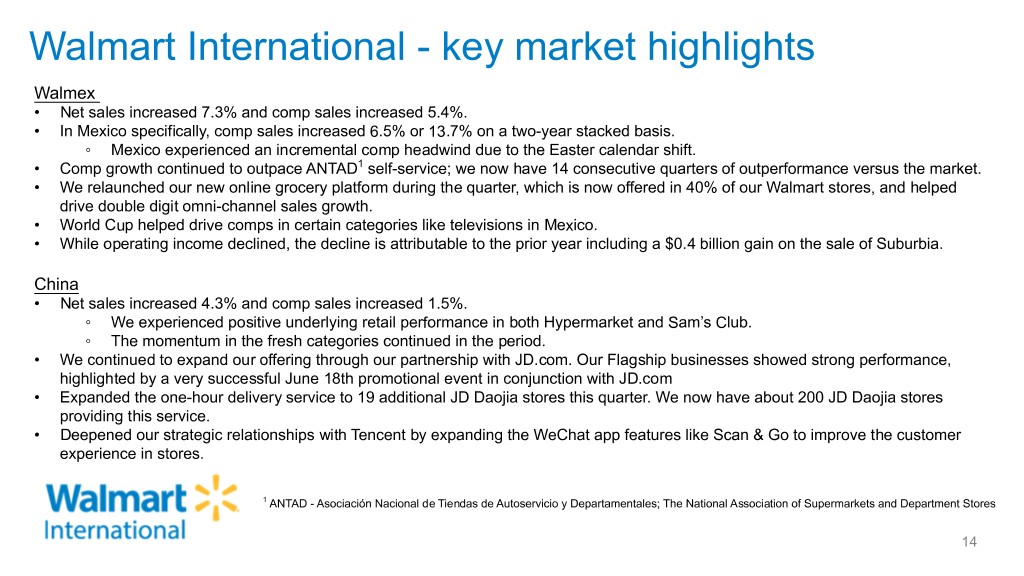
Walmart International - key market highlights Walmex • Net sales increased 7.3% and comp sales increased 5.4%. • In Mexico specifically, comp sales increased 6.5% or 13.7% on a two-year stacked basis. ◦ Mexico experienced an incremental comp headwind due to the Easter calendar shift. • Comp growth continued to outpace ANTAD1 self-service; we now have 14 consecutive quarters of outperformance versus the market. • We relaunched our new online grocery platform during the quarter, which is now offered in 40% of our Walmart stores, and helped drive double digit omni-channel sales growth. • World Cup helped drive comps in certain categories like televisions in Mexico. • While operating income declined, the decline is attributable to the prior year including a $0.4 billion gain on the sale of Suburbia. China • Net sales increased 4.3% and comp sales increased 1.5%. ◦ We experienced positive underlying retail performance in both Hypermarket and Sam’s Club. ◦ The momentum in the fresh categories continued in the period. • We continued to expand our offering through our partnership with JD.com. Our Flagship businesses showed strong performance, highlighted by a very successful June 18th promotional event in conjunction with JD.com • Expanded the one-hour delivery service to 19 additional JD Daojia stores this quarter. We now have about 200 JD Daojia stores providing this service. • Deepened our strategic relationships with Tencent by expanding the WeChat app features like Scan & Go to improve the customer experience in stores. 1 ANTAD - Asociación Nacional de Tiendas de Autoservicio y Departamentales; The National Association of Supermarkets and Department Stores 14
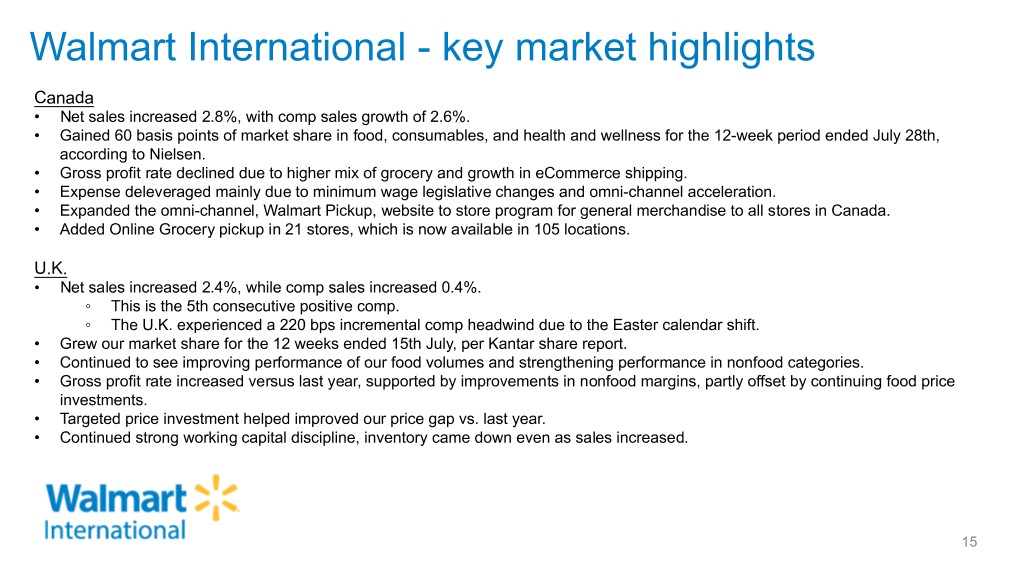
Walmart International - key market highlights Canada • Net sales increased 2.8%, with comp sales growth of 2.6%. • Gained 60 basis points of market share in food, consumables, and health and wellness for the 12-week period ended July 28th, according to Nielsen. • Gross profit rate declined due to higher mix of grocery and growth in eCommerce shipping. • Expense deleveraged mainly due to minimum wage legislative changes and omni-channel acceleration. • Expanded the omni-channel, Walmart Pickup, website to store program for general merchandise to all stores in Canada. • Added Online Grocery pickup in 21 stores, which is now available in 105 locations. U.K. • Net sales increased 2.4%, while comp sales increased 0.4%. ◦ This is the 5th consecutive positive comp. ◦ The U.K. experienced a 220 bps incremental comp headwind due to the Easter calendar shift. • Grew our market share for the 12 weeks ended 15th July, per Kantar share report. • Continued to see improving performance of our food volumes and strengthening performance in nonfood categories. • Gross profit rate increased versus last year, supported by improvements in nonfood margins, partly offset by continuing food price investments. • Targeted price investment helped improved our price gap vs. last year. • Continued strong working capital discipline, inventory came down even as sales increased. 15
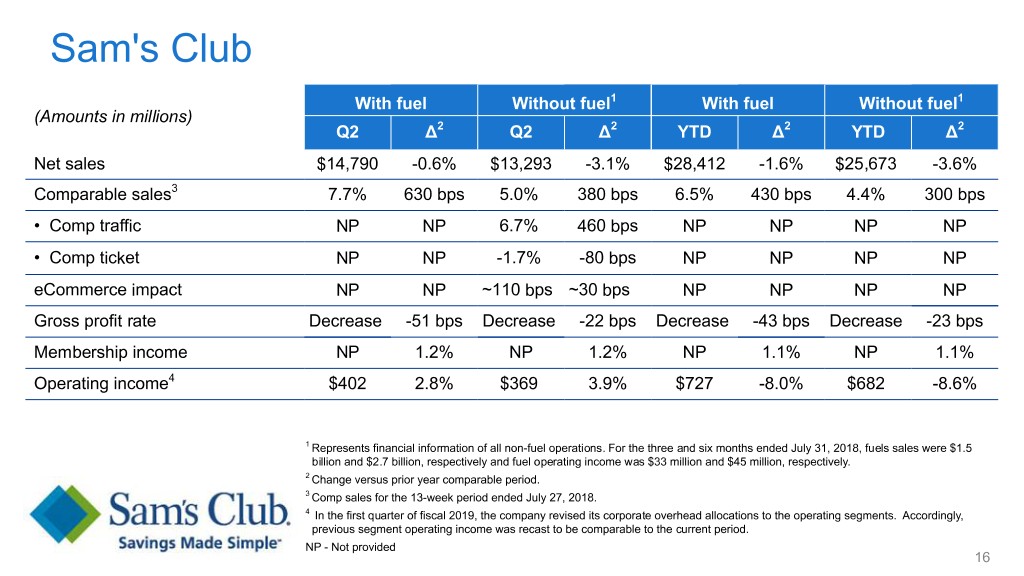
Sam's Club With fuel Without fuel1 With fuel Without fuel1 (Amounts in millions) Q2 Δ2 Q2 Δ2 YTD Δ2 YTD Δ2 Net sales $14,790 -0.6% $13,293 -3.1% $28,412 -1.6% $25,673 -3.6% Comparable sales3 7.7% 630 bps 5.0% 380 bps 6.5% 430 bps 4.4% 300 bps • Comp traffic NP NP 6.7% 460 bps NP NP NP NP • Comp ticket NP NP -1.7% -80 bps NP NP NP NP eCommerce impact NP NP ~110 bps ~30 bps NP NP NP NP Gross profit rate Decrease -51 bps Decrease -22 bps Decrease -43 bps Decrease -23 bps Membership income NP 1.2% NP 1.2% NP 1.1% NP 1.1% Operating income4 $402 2.8% $369 3.9% $727 -8.0% $682 -8.6% 1 Represents financial information of all non-fuel operations. For the three and six months ended July 31, 2018, fuels sales were $1.5 billion and $2.7 billion, respectively and fuel operating income was $33 million and $45 million, respectively. 2 Change versus prior year comparable period. 3 Comp sales for the 13-week period ended July 27, 2018. 4 In the first quarter of fiscal 2019, the company revised its corporate overhead allocations to the operating segments. Accordingly, previous segment operating income was recast to be comparable to the current period. NP - Not provided 16
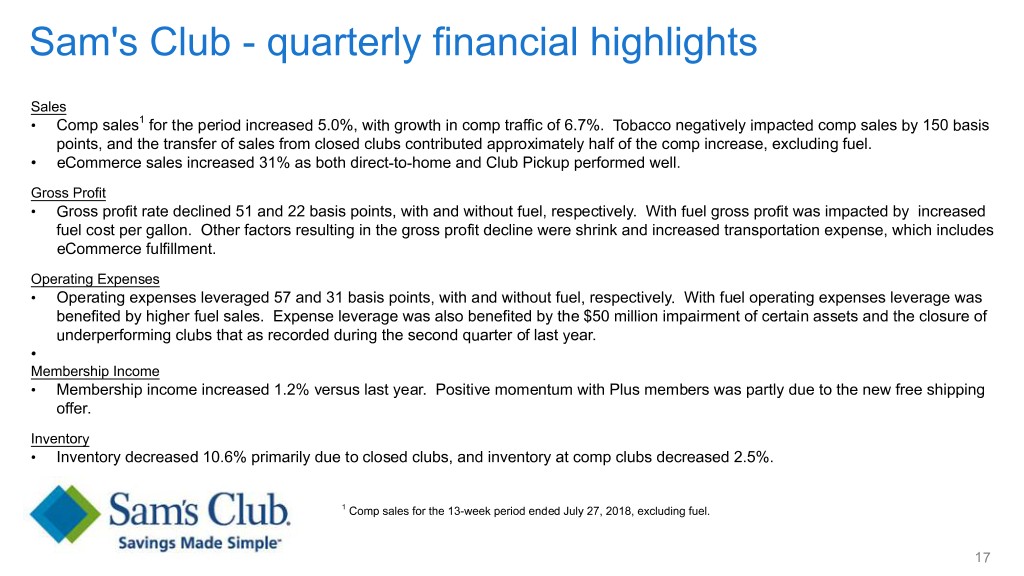
Sam's Club - quarterly financial highlights Sales • Comp sales1 for the period increased 5.0%, with growth in comp traffic of 6.7%. Tobacco negatively impacted comp sales by 150 basis points, and the transfer of sales from closed clubs contributed approximately half of the comp increase, excluding fuel. • eCommerce sales increased 31% as both direct-to-home and Club Pickup performed well. Gross Profit • Gross profit rate declined 51 and 22 basis points, with and without fuel, respectively. With fuel gross profit was impacted by increased fuel cost per gallon. Other factors resulting in the gross profit decline were shrink and increased transportation expense, which includes eCommerce fulfillment. Operating Expenses • Operating expenses leveraged 57 and 31 basis points, with and without fuel, respectively. With fuel operating expenses leverage was benefited by higher fuel sales. Expense leverage was also benefited by the $50 million impairment of certain assets and the closure of underperforming clubs that as recorded during the second quarter of last year. • Membership Income • Membership income increased 1.2% versus last year. Positive momentum with Plus members was partly due to the new free shipping offer. Inventory • Inventory decreased 10.6% primarily due to closed clubs, and inventory at comp clubs decreased 2.5%. 1 Comp sales for the 13-week period ended July 27, 2018, excluding fuel. 17
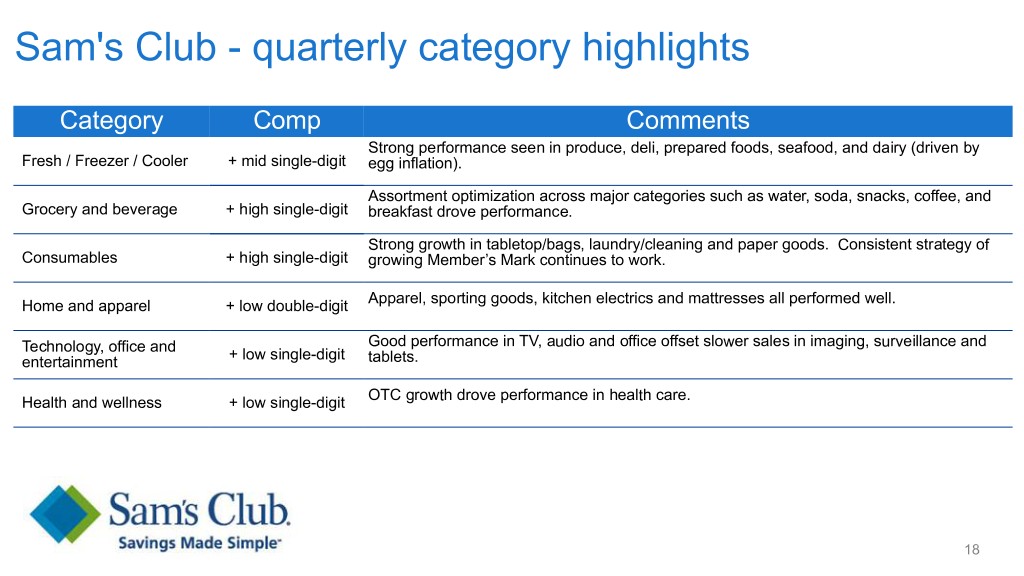
Sam's Club - quarterly category highlights Category Comp Comments Strong performance seen in produce, deli, prepared foods, seafood, and dairy (driven by Fresh / Freezer / Cooler + mid single-digit egg inflation). Assortment optimization across major categories such as water, soda, snacks, coffee, and Grocery and beverage + high single-digit breakfast drove performance. Strong growth in tabletop/bags, laundry/cleaning and paper goods. Consistent strategy of Consumables + high single-digit growing Member’s Mark continues to work. Home and apparel + low double-digit Apparel, sporting goods, kitchen electrics and mattresses all performed well. Technology, office and Good performance in TV, audio and office offset slower sales in imaging, surveillance and entertainment + low single-digit tablets. Health and wellness + low single-digit OTC growth drove performance in health care. 18

Third-party FCPA and compliance-related expenses Q2 YTD (Amounts in millions) FY19 FY18 FY19 FY18 Ongoing inquiries and investigations $5 $7 $8 $20 Global compliance program and organizational enhancements 3 5 7 8 Total $8 $12 $15 $28 • These expenses are included in our Corporate and support expenses. 19
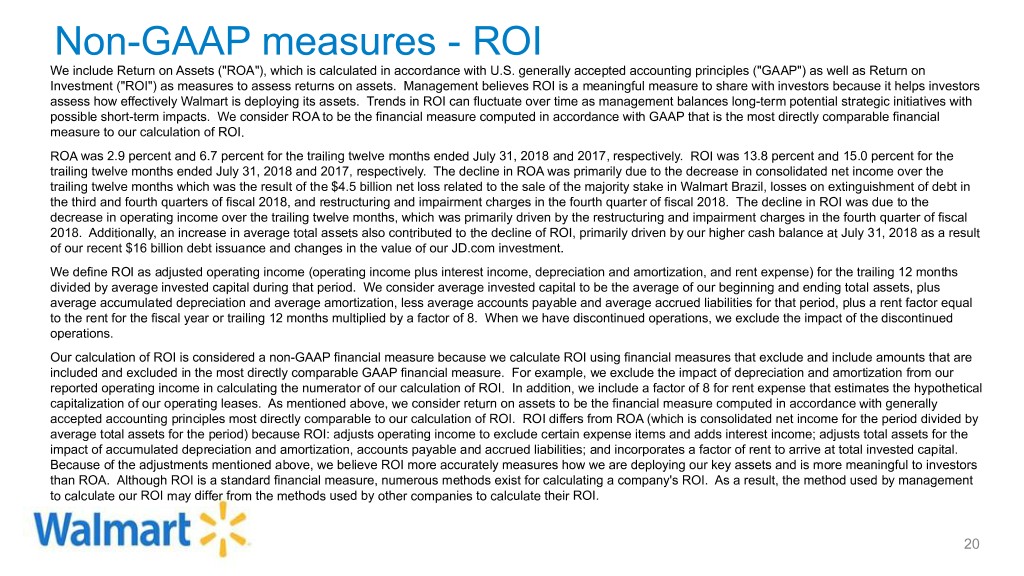
Non-GAAP measures - ROI We include Return on Assets ("ROA"), which is calculated in accordance with U.S. generally accepted accounting principles ("GAAP") as well as Return on Investment ("ROI") as measures to assess returns on assets. Management believes ROI is a meaningful measure to share with investors because it helps investors assess how effectively Walmart is deploying its assets. Trends in ROI can fluctuate over time as management balances long-term potential strategic initiatives with possible short-term impacts. We consider ROA to be the financial measure computed in accordance with GAAP that is the most directly comparable financial measure to our calculation of ROI. ROA was 2.9 percent and 6.7 percent for the trailing twelve months ended July 31, 2018 and 2017, respectively. ROI was 13.8 percent and 15.0 percent for the trailing twelve months ended July 31, 2018 and 2017, respectively. The decline in ROA was primarily due to the decrease in consolidated net income over the trailing twelve months which was the result of the $4.5 billion net loss related to the sale of the majority stake in Walmart Brazil, losses on extinguishment of debt in the third and fourth quarters of fiscal 2018, and restructuring and impairment charges in the fourth quarter of fiscal 2018. The decline in ROI was due to the decrease in operating income over the trailing twelve months, which was primarily driven by the restructuring and impairment charges in the fourth quarter of fiscal 2018. Additionally, an increase in average total assets also contributed to the decline of ROI, primarily driven by our higher cash balance at July 31, 2018 as a result of our recent $16 billion debt issuance and changes in the value of our JD.com investment. We define ROI as adjusted operating income (operating income plus interest income, depreciation and amortization, and rent expense) for the trailing 12 months divided by average invested capital during that period. We consider average invested capital to be the average of our beginning and ending total assets, plus average accumulated depreciation and average amortization, less average accounts payable and average accrued liabilities for that period, plus a rent factor equal to the rent for the fiscal year or trailing 12 months multiplied by a factor of 8. When we have discontinued operations, we exclude the impact of the discontinued operations. Our calculation of ROI is considered a non-GAAP financial measure because we calculate ROI using financial measures that exclude and include amounts that are included and excluded in the most directly comparable GAAP financial measure. For example, we exclude the impact of depreciation and amortization from our reported operating income in calculating the numerator of our calculation of ROI. In addition, we include a factor of 8 for rent expense that estimates the hypothetical capitalization of our operating leases. As mentioned above, we consider return on assets to be the financial measure computed in accordance with generally accepted accounting principles most directly comparable to our calculation of ROI. ROI differs from ROA (which is consolidated net income for the period divided by average total assets for the period) because ROI: adjusts operating income to exclude certain expense items and adds interest income; adjusts total assets for the impact of accumulated depreciation and amortization, accounts payable and accrued liabilities; and incorporates a factor of rent to arrive at total invested capital. Because of the adjustments mentioned above, we believe ROI more accurately measures how we are deploying our key assets and is more meaningful to investors than ROA. Although ROI is a standard financial measure, numerous methods exist for calculating a company's ROI. As a result, the method used by management to calculate our ROI may differ from the methods used by other companies to calculate their ROI. 20
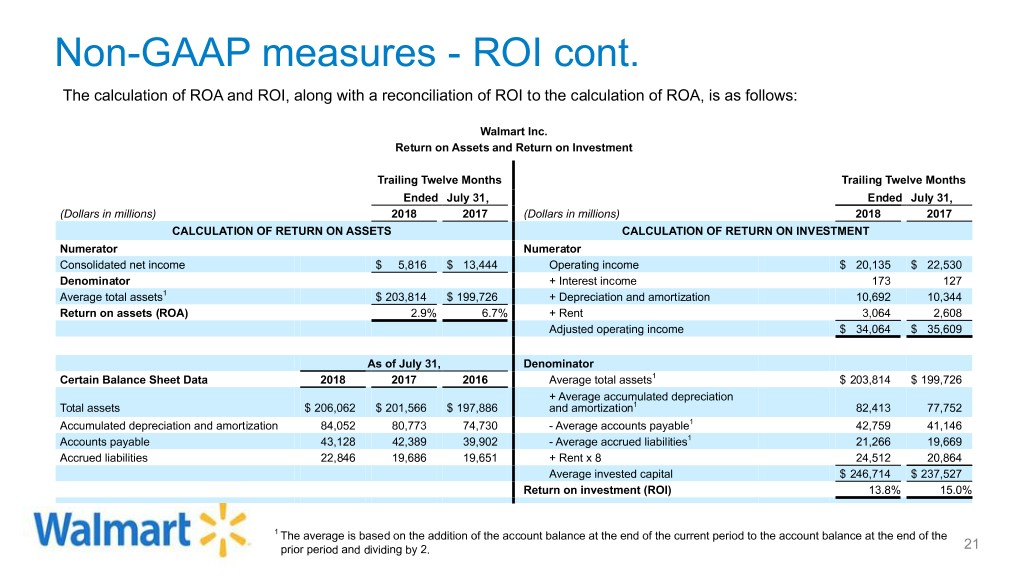
Non-GAAP measures - ROI cont. The calculation of ROA and ROI, along with a reconciliation of ROI to the calculation of ROA, is as follows: Walmart Inc. Return on Assets and Return on Investment Trailing Twelve Months Trailing Twelve Months Ended July 31, Ended July 31, (Dollars in millions) 2018 2017 (Dollars in millions) 2018 2017 CALCULATION OF RETURN ON ASSETS CALCULATION OF RETURN ON INVESTMENT Numerator Numerator Consolidated net income $ 5,816 $ 13,444 Operating income $ 20,135 $ 22,530 Denominator + Interest income 173 127 Average total assets1 $ 203,814 $ 199,726 + Depreciation and amortization 10,692 10,344 Return on assets (ROA) 2.9% 6.7% + Rent 3,064 2,608 Adjusted operating income $ 34,064 $ 35,609 As of July 31, Denominator Certain Balance Sheet Data 2018 2017 2016 Average total assets1 $ 203,814 $ 199,726 + Average accumulated depreciation Total assets $ 206,062 $ 201,566 $ 197,886 and amortization1 82,413 77,752 Accumulated depreciation and amortization 84,052 80,773 74,730 - Average accounts payable1 42,759 41,146 Accounts payable 43,128 42,389 39,902 - Average accrued liabilities1 21,266 19,669 Accrued liabilities 22,846 19,686 19,651 + Rent x 8 24,512 20,864 Average invested capital $ 246,714 $ 237,527 Return on investment (ROI) 13.8% 15.0% 1 The average is based on the addition of the account balance at the end of the current period to the account balance at the end of the prior period and dividing by 2. 21
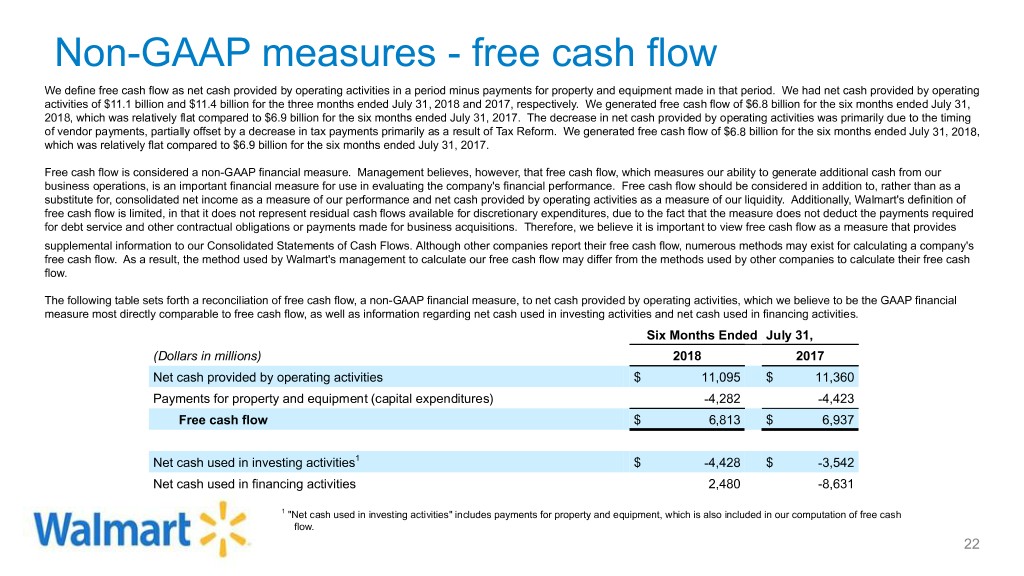
Non-GAAP measures - free cash flow We define free cash flow as net cash provided by operating activities in a period minus payments for property and equipment made in that period. We had net cash provided by operating activities of $11.1 billion and $11.4 billion for the three months ended July 31, 2018 and 2017, respectively. We generated free cash flow of $6.8 billion for the six months ended July 31, 2018, which was relatively flat compared to $6.9 billion for the six months ended July 31, 2017. The decrease in net cash provided by operating activities was primarily due to the timing of vendor payments, partially offset by a decrease in tax payments primarily as a result of Tax Reform. We generated free cash flow of $6.8 billion for the six months ended July 31, 2018, which was relatively flat compared to $6.9 billion for the six months ended July 31, 2017. Free cash flow is considered a non-GAAP financial measure. Management believes, however, that free cash flow, which measures our ability to generate additional cash from our business operations, is an important financial measure for use in evaluating the company's financial performance. Free cash flow should be considered in addition to, rather than as a substitute for, consolidated net income as a measure of our performance and net cash provided by operating activities as a measure of our liquidity. Additionally, Walmart's definition of free cash flow is limited, in that it does not represent residual cash flows available for discretionary expenditures, due to the fact that the measure does not deduct the payments required for debt service and other contractual obligations or payments made for business acquisitions. Therefore, we believe it is important to view free cash flow as a measure that provides supplemental information to our Consolidated Statements of Cash Flows. Although other companies report their free cash flow, numerous methods may exist for calculating a company's free cash flow. As a result, the method used by Walmart's management to calculate our free cash flow may differ from the methods used by other companies to calculate their free cash flow. The following table sets forth a reconciliation of free cash flow, a non-GAAP financial measure, to net cash provided by operating activities, which we believe to be the GAAP financial measure most directly comparable to free cash flow, as well as information regarding net cash used in investing activities and net cash used in financing activities. Six Months Ended July 31, (Dollars in millions) 2018 2017 Net cash provided by operating activities $ 11,095 $ 11,360 Payments for property and equipment (capital expenditures) -4,282 -4,423 Free cash flow $ 6,813 $ 6,937 Net cash used in investing activities1 $ -4,428 $ -3,542 Net cash used in financing activities 2,480 -8,631 1 "Net cash used in investing activities" includes payments for property and equipment, which is also included in our computation of free cash flow. 22
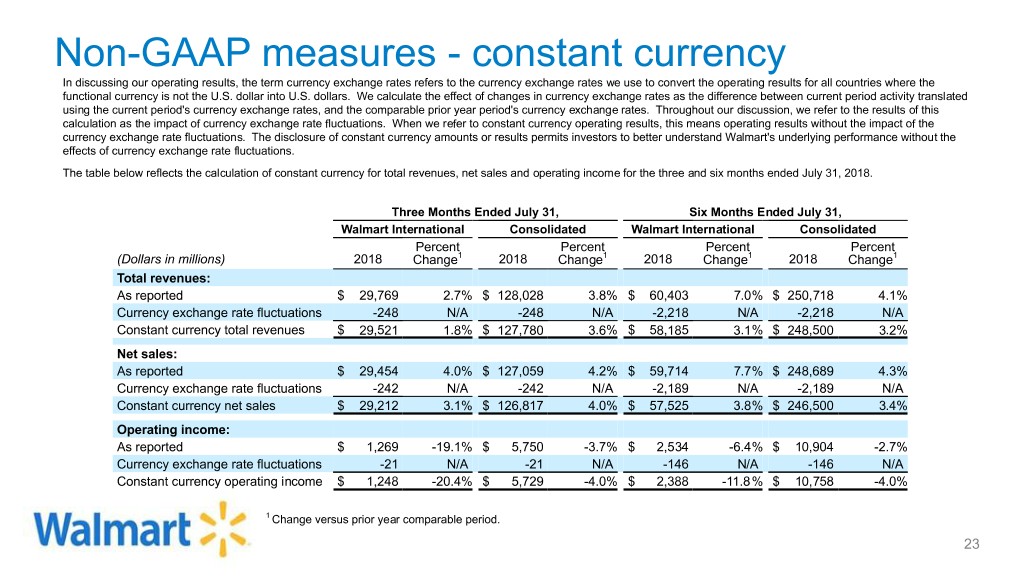
Non-GAAP measures - constant currency In discussing our operating results, the term currency exchange rates refers to the currency exchange rates we use to convert the operating results for all countries where the functional currency is not the U.S. dollar into U.S. dollars. We calculate the effect of changes in currency exchange rates as the difference between current period activity translated using the current period's currency exchange rates, and the comparable prior year period's currency exchange rates. Throughout our discussion, we refer to the results of this calculation as the impact of currency exchange rate fluctuations. When we refer to constant currency operating results, this means operating results without the impact of the currency exchange rate fluctuations. The disclosure of constant currency amounts or results permits investors to better understand Walmart's underlying performance without the effects of currency exchange rate fluctuations. The table below reflects the calculation of constant currency for total revenues, net sales and operating income for the three and six months ended July 31, 2018. Three Months Ended July 31, Six Months Ended July 31, Walmart International Consolidated Walmart International Consolidated Percent Percent Percent Percent (Dollars in millions) 2018 Change1 2018 Change1 2018 Change1 2018 Change1 Total revenues: As reported $ 29,769 2.7% $ 128,028 3.8% $ 60,403 7.0% $ 250,718 4.1% Currency exchange rate fluctuations -248 N/A -248 N/A -2,218 N/A -2,218 N/A Constant currency total revenues $ 29,521 1.8% $ 127,780 3.6% $ 58,185 3.1% $ 248,500 3.2% Net sales: As reported $ 29,454 4.0% $ 127,059 4.2% $ 59,714 7.7% $ 248,689 4.3% Currency exchange rate fluctuations -242 N/A -242 N/A -2,189 N/A -2,189 N/A Constant currency net sales $ 29,212 3.1% $ 126,817 4.0% $ 57,525 3.8% $ 246,500 3.4% Operating income: As reported $ 1,269 -19.1% $ 5,750 -3.7% $ 2,534 -6.4% $ 10,904 -2.7% Currency exchange rate fluctuations -21 N/A -21 N/A -146 N/A -146 N/A Constant currency operating income $ 1,248 -20.4% $ 5,729 -4.0% $ 2,388 -11.8% $ 10,758 -4.0% 1 Change versus prior year comparable period. 23
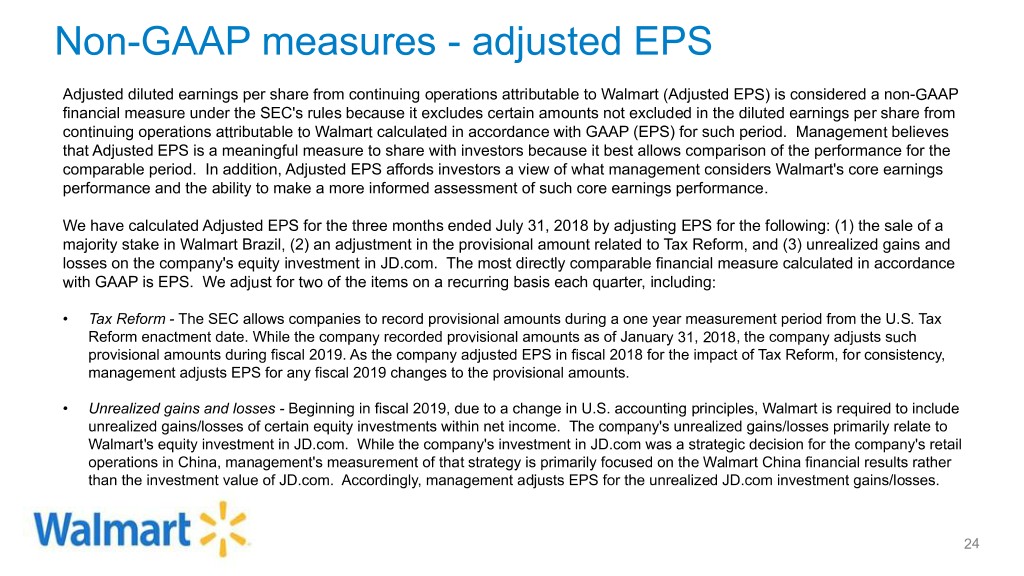
Non-GAAP measures - adjusted EPS Adjusted diluted earnings per share from continuing operations attributable to Walmart (Adjusted EPS) is considered a non-GAAP financial measure under the SEC's rules because it excludes certain amounts not excluded in the diluted earnings per share from continuing operations attributable to Walmart calculated in accordance with GAAP (EPS) for such period. Management believes that Adjusted EPS is a meaningful measure to share with investors because it best allows comparison of the performance for the comparable period. In addition, Adjusted EPS affords investors a view of what management considers Walmart's core earnings performance and the ability to make a more informed assessment of such core earnings performance. We have calculated Adjusted EPS for the three months ended July 31, 2018 by adjusting EPS for the following: (1) the sale of a majority stake in Walmart Brazil, (2) an adjustment in the provisional amount related to Tax Reform, and (3) unrealized gains and losses on the company's equity investment in JD.com. The most directly comparable financial measure calculated in accordance with GAAP is EPS. We adjust for two of the items on a recurring basis each quarter, including: • Tax Reform - The SEC allows companies to record provisional amounts during a one year measurement period from the U.S. Tax Reform enactment date. While the company recorded provisional amounts as of January 31, 2018, the company adjusts such provisional amounts during fiscal 2019. As the company adjusted EPS in fiscal 2018 for the impact of Tax Reform, for consistency, management adjusts EPS for any fiscal 2019 changes to the provisional amounts. • Unrealized gains and losses - Beginning in fiscal 2019, due to a change in U.S. accounting principles, Walmart is required to include unrealized gains/losses of certain equity investments within net income. The company's unrealized gains/losses primarily relate to Walmart's equity investment in JD.com. While the company's investment in JD.com was a strategic decision for the company's retail operations in China, management's measurement of that strategy is primarily focused on the Walmart China financial results rather than the investment value of JD.com. Accordingly, management adjusts EPS for the unrealized JD.com investment gains/losses. 24
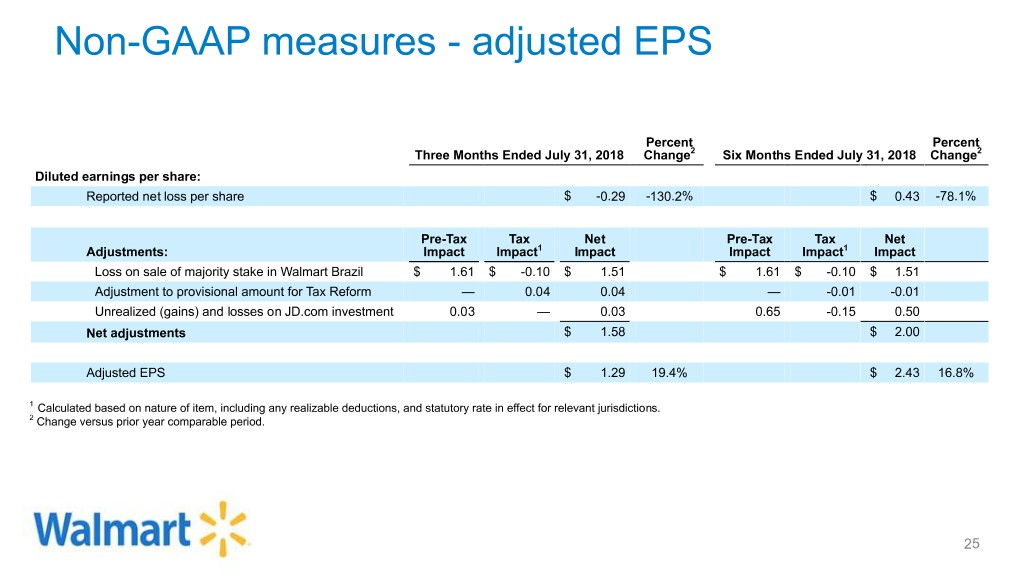
Non-GAAP measures - adjusted EPS Percent Percent Three Months Ended July 31, 2018 Change2 Six Months Ended July 31, 2018 Change2 Diluted earnings per share: Reported net loss per share $ -0.29 -130.2% $ 0.43 -78.1% Pre-Tax Tax Net Pre-Tax Tax Net Adjustments: Impact Impact1 Impact Impact Impact1 Impact Loss on sale of majority stake in Walmart Brazil $ 1.61 $ -0.10 $ 1.51 $ 1.61 $ -0.10 $ 1.51 Adjustment to provisional amount for Tax Reform — 0.04 0.04 — -0.01 -0.01 Unrealized (gains) and losses on JD.com investment 0.03 — 0.03 0.65 -0.15 0.50 Net adjustments $ 1.58 $ 2.00 Adjusted EPS $ 1.29 19.4% $ 2.43 16.8% 1 Calculated based on nature of item, including any realizable deductions, and statutory rate in effect for relevant jurisdictions. 2 Change versus prior year comparable period. 25

Non-GAAP measures - adjusted EPS As previously disclosed in our second quarter ended July 31, 2017 press release, we have calculated Adjusted EPS for the three months ended July 31, 2017 by adjusting EPS for the following: (1) the loss on the early extinguishment of certain debt and (2) the gain on the sale of Suburbia in Mexico. The most directly comparable financial measure calculated in accordance with GAAP is EPS. Three Months Ended July 31, 2017 Six Months Ended July 31, 2017 Diluted earnings per share: Reported EPS $0.96 $1.96 Pre-Tax Tax NCI Pre-Tax Tax NCI Adjustments: Impact Impact1 Impact2 Net Impact Impact Impact1 Impact2 Net Impact Loss on early extinguishment of debt $0.26 -$0.09 $— $0.17 $0.26 -$0.09 $— $0.17 Gain on sale of Suburbia -0.13 0.04 0.04 -0.05 -0.13 0.04 0.04 -0.05 Net adjustments $0.12 $0.12 Adjusted EPS $1.08 $2.08 1 Calculated based on nature of item and statutory rate in effect for relevant jurisdictions. 2 Calculated based on the ownership percentages of the noncontrolling interest at Walmex. 26
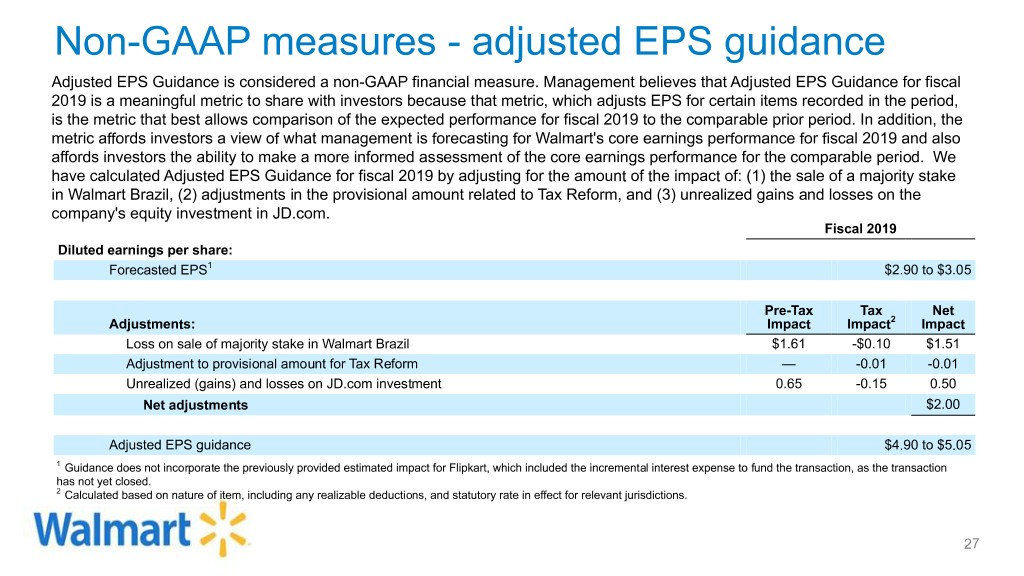
Non-GAAP measures - adjusted EPS guidance Adjusted EPS Guidance is considered a non-GAAP financial measure. Management believes that Adjusted EPS Guidance for fiscal 2019 is a meaningful metric to share with investors because that metric, which adjusts EPS for certain items recorded in the period, is the metric that best allows comparison of the expected performance for fiscal 2019 to the comparable prior period. In addition, the metric affords investors a view of what management is forecasting for Walmart's core earnings performance for fiscal 2019 and also affords investors the ability to make a more informed assessment of the core earnings performance for the comparable period. We have calculated Adjusted EPS Guidance for fiscal 2019 by adjusting for the amount of the impact of: (1) the sale of a majority stake in Walmart Brazil, (2) adjustments in the provisional amount related to Tax Reform, and (3) unrealized gains and losses on the company's equity investment in JD.com. Fiscal 2019 Diluted earnings per share: Forecasted EPS1 $2.90 to $3.05 Pre-Tax Tax Net Adjustments: Impact Impact2 Impact Loss on sale of majority stake in Walmart Brazil $1.61 -$0.10 $1.51 Adjustment to provisional amount for Tax Reform — -0.01 -0.01 Unrealized (gains) and losses on JD.com investment 0.65 -0.15 0.50 Net adjustments $2.00 Adjusted EPS guidance $4.90 to $5.05 1 Guidance does not incorporate the previously provided estimated impact for Flipkart, which included the incremental interest expense to fund the transaction, as the transaction has not yet closed. 2 Calculated based on nature of item, including any realizable deductions, and statutory rate in effect for relevant jurisdictions. 27
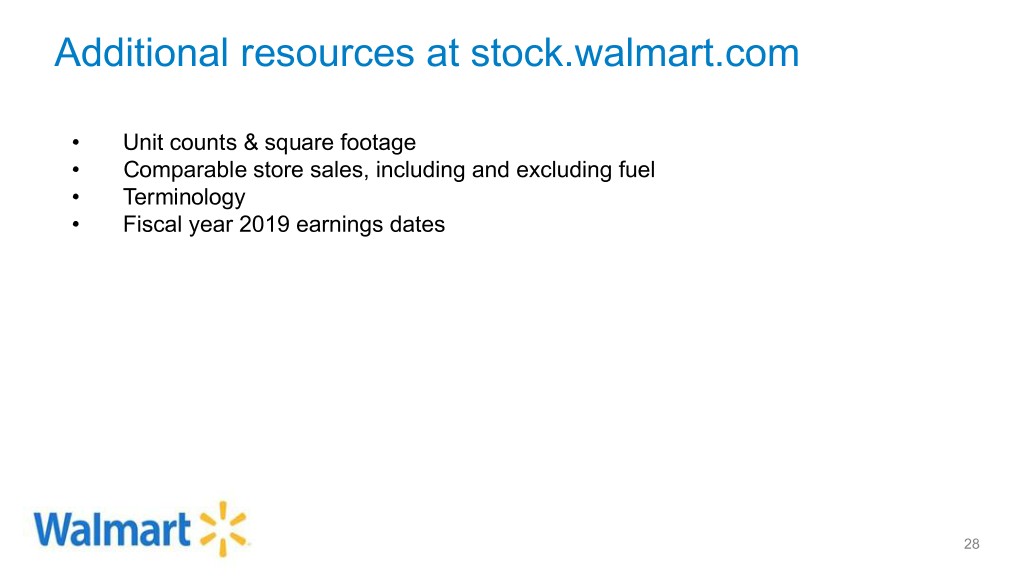
Additional resources at stock.walmart.com • Unit counts & square footage • Comparable store sales, including and excluding fuel • Terminology • Fiscal year 2019 earnings dates 28
